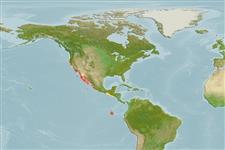Preferred temperature (Ref.
123201): 15.2 - 25.9, mean 21.6 °C (based on 58 cells).
Phylogenetic diversity index (Ref.
82804): PD
50 = 0.5000 [Uniqueness, from 0.5 = low to 2.0 = high].
Bayesian length-weight: a=0.00479 (0.00284 - 0.00808), b=3.12 (2.97 - 3.27), in cm total length, based on LWR estimates for this species & Genus-body shape (Ref.
93245).
Nível Trófico (Ref.
69278): 4.5 ±0.80 se; based on food items.
Resiliência (Ref.
120179): Médio, tempo mínimo de duplicação da população 1,4 - 4,4 anos (Preliminary K or Fecundity.).
Fishing Vulnerability (Ref.
59153): Moderate to high vulnerability (46 of 100).
Nutrients (Ref.
124155): Calcium = 19.2 [6.2, 42.9] mg/100g; Iron = 0.412 [0.140, 0.958] mg/100g; Protein = 16.7 [13.7, 19.1] %; Omega3 = 0.0982 [, ] g/100g; Selenium = 22.5 [8.2, 52.2] μg/100g; VitaminA = 49.8 [12.1, 182.6] μg/100g; Zinc = 0.469 [0.266, 0.767] mg/100g (wet weight);
